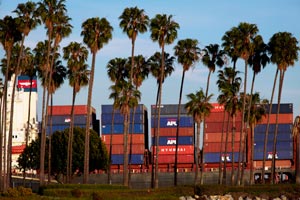Ports on Both Coasts Post Record-High Container Traffic in 2016

It was a record-setting year in 2016 for several of the top North American container ports, although the Hanjin Shipping Co. bankruptcy filing in August dashed hopes for a strong showing at the country’s second-largest port.
The Port of Los Angeles retained its place atop the list in North America, setting a record for the busiest year ever for a container port in the Western Hemisphere, according to data from the American Association of Port Authorities.
The L.A. port authority announced that its terminals handled 8,856,782 industry-standard 20-foot-equivalent units in 2016, breaking the 10-year-old mark of 8,469,853. The 2016 results were an 8.5% gain from the 8,160,458 TEUs in 2015 and marked the sixth time in 10 years that the port broke the 8 million mark. No other port in North America has surpassed that milestone once.
“To handle this much volume with minimal issues is an extraordinary accomplishment and demonstrates our capability-building efforts here in the San Pedro Bay complex,” said Gene Seroka, executive director of the Port of Los Angeles.
“The San Pedro Bay port complex is unmatched in North America when it comes to speed, efficiency and reliability, and these record numbers are proof,” said John McLaurin, president of the Pacific Merchant Shipping Association. “Along with the increase in cargo, we’re particularly proud that we’re seeing increased efficiencies at our terminals, specifically with decreases in the amount of time it takes to pick up a container after it’s been unloaded from a ship.”
Data from the Harbor Trucking Association, which tracks turn times for trucks using GPS technology, also confirmed that 2016 was a better year than 2015. The average turn times at the ports of Los Angeles and Long Beach were more than an hour, but the numbers were lower each month compared with the same period in 2015.
On the other hand, the Port of Long Beach, California, suffered a difficult 2016 as a result of the Hanjin Shipping Co. bankruptcy filing in August. Through Aug. 27, Hanjin transported 2½ times more container traffic to Long Beach than Los Angeles, according to bill of lading data compiled by Datamyne. Hanjin accounted for about 12.3% of the total container volume in Long Beach before the bankruptcy, according to port officials. In Los Angeles, it was only 4%.
For the full year, Long Beach container terminals processed 6,775,171 TEUs, a 5.8% drop from the 7,192,066 in 2015.
The collapse also created a vacuum at Total Terminals International, a Hanjin majority-owned subsidiary that operated Pier T. The Harbor Commission in December approved a deal to allow minority-owner Mediterranean Shipping Co. to take sole control of the long-term lease, although the Wall Street Journal reported that creditors have asked the U.S. District Court in New Jersey to delay or block the $78 million deal.
“As the new year starts, we’re grateful to be able to put the Hanjin bankruptcy behind us,” said Duane Kenagy, interim CEO of the Port of Long Beach. “At the same time, MSC’s quick interest in Pier T once it became available shows the facility’s value to the industry. We’re looking forward to a mutually beneficial partnership with MSC and the 2M Alliance [a Maersk Group-MSC alliance].”
Despite the drop-off, it’s likely that Long Beach will remain the second-busiest in North America, based on the first 11 months of data at No. 3, the Port of New York and New Jersey.
The Port of Virginia, which ranks No. 7 in North America, also set a new annual record for container cargo volume with 2,655,705 TEUs, a 4.2% increase versus 2015. Imports were up 6%, and exports were up 2.6%.
“The growth is significant — 8,800 TEUs a month, on average — and we have responded with improved throughput in all facets of the operation, especially rail, where volume was 551,496 containers, an increase of 14% when compared with 2015,” said John Reinhart, executive director of the Virginia Port Authority.
The Port of Oakland, California, benefited from the strong year in container volumes, although not record-breaking. The port authority announced the stevedores processed 2,369,641 TEUs, or a 4% increase from 2015. It was the third-largest total in port history, only slightly behind the record of 2,394,069 in 2014. Containerized exports to Asia, which accounted for more than half of all volume, jumped 10.5% in 2016, according to port information. The port ranks No. 9 in North America but could jump up one position, depending on the final numbers from Manzanillo, Mexico.
“This is a gratifying outcome,” said John Driscoll, maritime director for Port of Oakland. “The job now is clear — build on the momentum we created in 2016.”
The Port of Charleston, South Carolina, broke a record set in 2005 when it recorded a total of more than 1,996,000 TEUs in 2016, up 1.2% compared with the year before. Inland Port Greer near Charleston, South Carolina, handled a record 103,639 rail lifts in 2016, a 38% increase from the previous calendar year.
“This is a significant accomplishment for the SCPA, of which we are very proud,” said Jim Newsome, CEO of the South Carolina Port Authority. “Our focus is squarely on realizing ongoing enhancements to handle the significant deployment of big containerships, specifically refurbishing our wharves, raising our cranes, deepening our harbor as soon as possible and expanding our successful inland port network.”

